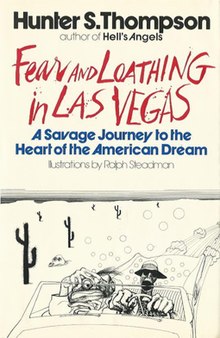Fear and Loathing in Las Vegas (novel)

First edition
|
|
| Author | Hunter S. Thompson |
|---|---|
| Illustrator | Ralph Steadman |
| Country | United States |
| Language | English |
| Series | Gonzo Series |
| Genre | Gonzo journalism |
| Publisher | Random House |
|
Publication date
|
November 11, 1971 and November 25, 1971 (magazine) July 1972 (book) |
| Media type | Print (Hardback & Paperback) |
| Pages | 204 pp |
| ISBN | |
| OCLC | 41049769 |
| 070/.92 B 21 | |
| LC Class | PN4874.T444 A3 1998b |
Fear and Loathing in Las Vegas: A Savage Journey to the Heart of the American Dream is a novel by Hunter S. Thompson, illustrated by Ralph Steadman. The book is a roman à clef, rooted in autobiographical incidents. The story follows its protagonist, Raoul Duke, and his attorney, Dr. Gonzo, as they descend on Las Vegas to chase the American Dream through a drug-induced haze, all the while ruminating on the failure of the 1960s countercultural movement. The work is Thompson's most famous, and is noted for its lurid descriptions of illegal drug use, its early retrospective on the culture of the 1960s, and its popularization of Thompson's highly subjective blend of fact and fiction that has become known as gonzo journalism. The novel first appeared as a two-part series in Rolling Stone magazine in 1971, was published as a book in 1972, and was later adapted into a film of the same name in 1998 by Terry Gilliam, starring Johnny Depp and Benicio del Toro who portrayed Raoul Duke and Dr. Gonzo, respectively.
The novel Fear and Loathing in Las Vegas is based on two trips to Las Vegas, Nevada, that Hunter S. Thompson took with attorney and Chicano activist Oscar Zeta Acosta in March and April 1971. The first trip resulted from an exposé Thompson was writing for Rolling Stone magazine about the Mexican-American television journalist Rubén Salazar, whom officers of the Los Angeles County Sheriff's Department had shot and killed with a tear gas grenade fired at close range during the National Chicano Moratorium March against the Vietnam War in 1970. Thompson was using Acosta—a prominent Mexican-American political activist and attorney—as a central source for the story, and the two found it difficult for a brown-skinned Mexican to talk openly with a white reporter in the racially tense atmosphere of Los Angeles, California. The two needed a more comfortable place to discuss the story and decided to take advantage of a Sports Illustrated magazine offer to write photograph captions for the annual Mint 400 desert race being held in Las Vegas from 21–23 March.
...
Wikipedia
